Latest Posts by enbylvania65000 - Page 5




the sunbittern is a bird found in tropical regions of the americas. despite its name and misleading body type, it is more closely related to tropicbirds than bitterns. the sunbittern is best known for its stunning plumage, featuring two orange ‘eyes’ that are used to scare off potential predators when the bird fans its wings. sunbitterns feed on a variety of prey, and are documented in captivity using tools, in this case lures to catch aquatic prey.
kofi
Hamster’s Paradise has gotten really weird and unsettling since I last followed it so no longer following it
Update on me and this tumblr
TL;DR: I am coming back to tumblr but also kind of not really. Also I have no idea how to use this site or what I’m doing I stopped using this account because of I wanted to avoid a flood of bad takes about the Russia-Ukraine War. I thought I won’t come back until the war is over, but I underestimated how long that would take and I suppose by now the flood of takes are over.
I’m still not going to blog politics here; if you want my political opinions I’d be happy to share them on Discord. This blog is for random cool stuff and worldbuilding. Also since I haven’t really been active since June last year there’s probably all sorts of changes to tumblr and to my friends that I’m unaware about. I’d like to know more. Definitely a lot has changed, for both good and bad, in my life since then.
Probably still will be a little inactive in the near future because I’m low on ideas and motivation for worldbuilding.
I haven’t been on this website since June I think. What’s changed? And what the hell is Post+?
I have a Twitter account devoted to Aeniith only now! Go follow me on @Aeniith_ if you’re so inclined!
Tidbits, musings, ideas, fact, and more on worldbuilding, conlangs, etc.
Haven’t been feeling like logging on for a few days. I’m still on twitter break so disabled my integration. Discord is really enough social interaction for me as is.
Muse Delusion - a love story with a touch of Greek mythology.
I was a beta reader so trust me this is a great book!
It's free for a limited time only so order now!

melt.
Now I feel bad doing absolutely nothing
Let aeniith be an inspiration to us all.
Conlangs in 2021
I usually try to keep my “resolutions” for the new year realistic, and think of them more as goals. I always like to have goals, and the new year gives me a convenient (if artificial) turning point that reminds me to consider and perhaps update my goals, especially those that are accomplishable over the period of about a year or so. A few of my conlang and worldbuilding goals for 2021 are: - Revise Rílin and Karkin grammars
- Add Ori to the website
- Add to Tosi grammar (it’s so barebones)
- Figure out how Gotevian/Lomi/other languages in Quarios are written.
- More music in Aeniithian conlangs! I recorded a few songs in 2019 in Rílin, Tosi, and Gotevian, and I want to do more.
- Record spoken audio stories that add to Aeniith worldbuilding (narrated exploration, in a sense)
- Do more drawings/paintings/visual designs related to Aeniith
- Fill out my flora and fauna collections and get them on the website Do you have any goals related to worldbuilding, writing, conlanging, or creation in general?
I really don’t like when jokes revolving around misinformation on an obscure or niche topic don’t include a label to say it’s a joke. It’s gaslighting people or misinforming those who never read on the topic before.

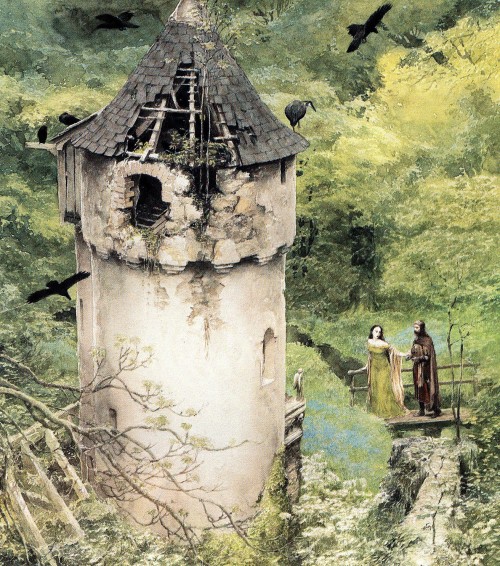
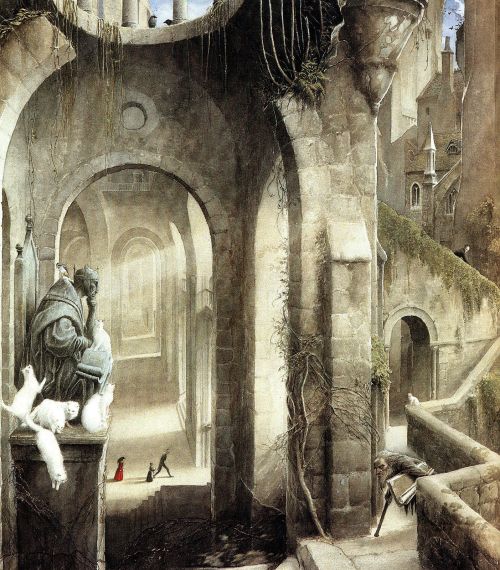



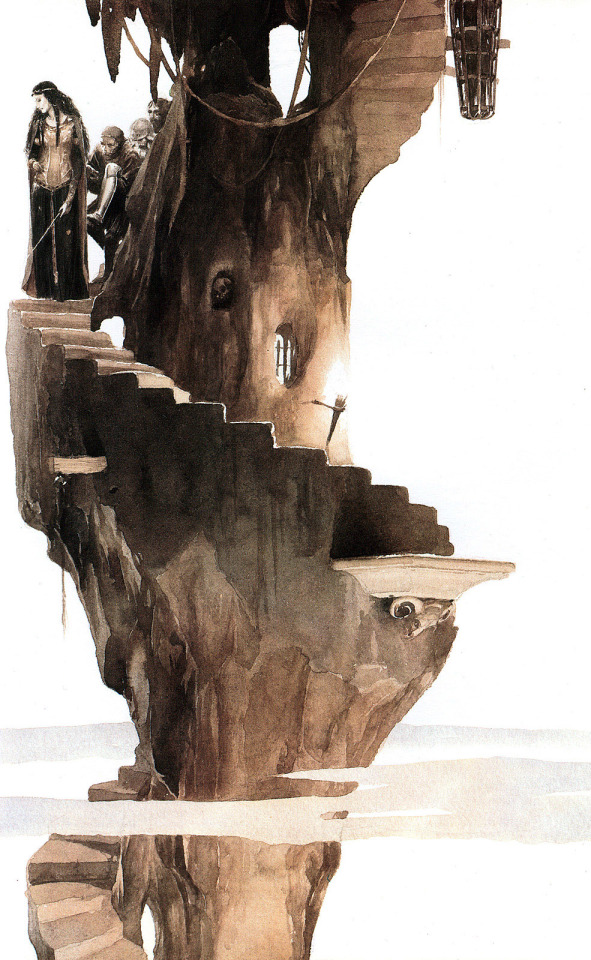
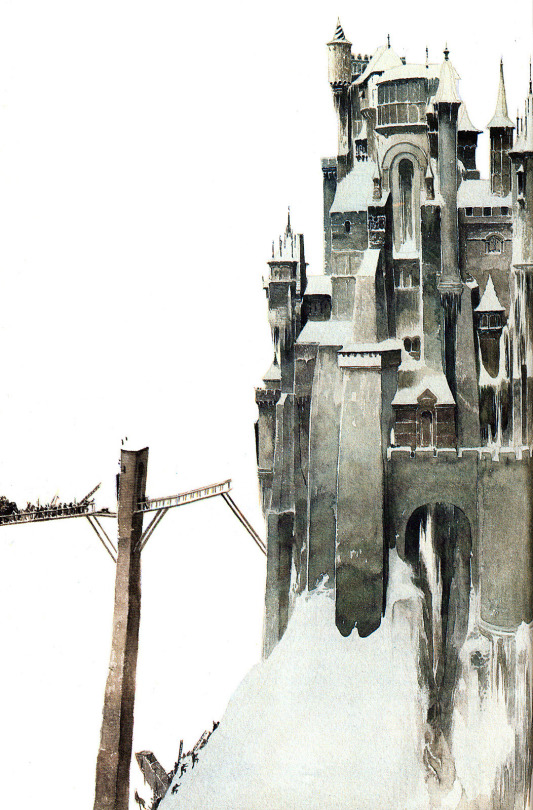
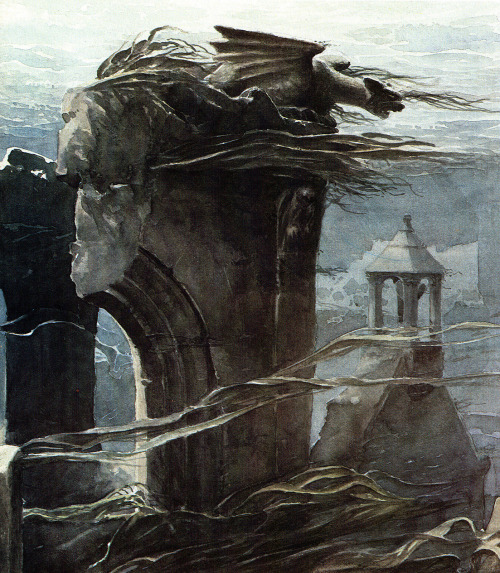
Castles - art by Alan Lee (1984)
I wonder if multilingual dnd characters work like multilingual people irl
Character 1: hey can you pass me the (demonic screeching)
Character 2: (visibly disturbed)
Character 1: (takes mundane object out of character 2s hands) sorry I forgot the word for it in common...
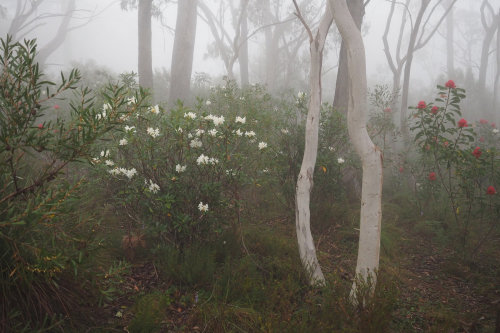

Campbell Gardens by trisharooni
The Early Therocene: 30 million years post-establishment

The Tooth Hurts: The Saber-Toothed Daggarat
The mison of the continent of Ecatoria, unlike their relatives in Westerna and Nodera, evolved a pair of prominent tusks as additional defenses against the unique native predators of the Ecatorian continent: the hamyenas. However, not even this would be enough, as eventually in the Early Therocene one species of hamyena eventually evolves to specifically prey upon mison: the saber-toothed daggarat (Smilocynomys scmitarodon).
Roughly the size of a Great Dane, the daggarat is the largest member of a group of distinctly canid-like hamyenas, the zingos. Specialized for running after prey on the open plains, they usually preyed upon smaller quarry such as boingos and hamtelopes, but the arrival of the mison from the northern continent of Westerna 5 million years ago set their sights on new prey -- and more specialized weaponry for tackling larger game.
The daggarat, like all hamyenas, sports a single long 'fang' made from the fusion of its upper incisors into a single stabbing point. However, in the daggarat, this fang can reach a length of up to six inches, and protrudes out of the mouth when the mouth is closed, to avoid injuring its own gums and lips. Hardened enamel protects the modified incisor from damage despite its exposure, and is strengthened with iron much like those of a beaver's teeth, which also grants it a distinctive orange hue. But unlike beaver teeth, the fang of the daggarat is not used for gnawing wood -- but for piercing through hide and flesh.
The primary hunting tactic of the daggarat is through persistence, singling out a straggler from a herd of mison and ambushing it. Able to open its jaws to a frightening 120 degrees, the daggarat quickly lunges in, stabs a few deep wounds into the mison intended to puncture large arteries, and promptly retreats, as an injured mison can easily trample and kill them in its panic. The daggarat then sits back and waits for the mison to move on, before harassing and wounding it again when it stops to rest or drink, putting up a prolonged cycle of attack, retreat, wait and attack once more, a process which can last as long as two to three days until exhausted and wounded, the mison finally succumbs to its injuries and the daggarat is rewarded for its patience with a huge food source that can last it for days.
Daggarats typically hunt in pairs, usually a mated couple, which cooperatively hunt together and aid one another in bringing down their large prey, and share the same den when they shelter at night. The pair are very closely bonded and rarely leave each other's side, and typically mate for life: only taking a new mate should their previous one die. The pair can produce a litter of three to five pups each breeding season (usually every two to three years), which the couple take turns caring for for at least ten months until they are weaned: by then, the father chases off the male offspring to fend for themselves, but female pups stick around for up to two years-- during which the resulting larger pack when hunting with their parents allows them a greater chance of success in quickly making a kill.
▪▪▪▪▪▪▪▪
The Early Therocene: 30 million years post-establishment

Tallest of All: The Girats
The great success of the boingos across the plains and grassland of the Early Therocene would spell bad news for the hamtelopes. While enjoying a brief success in the Middle Rodentocene, they would eventually be outcompeted by the boingos, with a more-efficient means of locomotion and more-specialized teeth for eating tough grasses. As such, the hamtelopes would be pressured into other niches as they were pushed out of the plains: many would become forest and jungle herbivores, others would remain as small hare-like grazers in the plains, and only on isolated environments do the hamtelopes get to dominate with the absence of competition.
But one family of hamtelopes stubbornly stuck to the plains, and despite the abundance of competing boingos grew to megafaunal sizes. However, they reached higher up, into the treetops where the boingos could not reach, and so were selected to grow taller still, and so this trend reaches its logical conclusion in the Early Therocene, with the tallest hamsters ever to walk the planet: the girats.
Towering high-browsers that feed on the sparse trees in the open plains, the girats reach tremendous heights of up to 16 feet, with their long legs and even longer necks. They evolved prehensile lips and long, flexible tongues to grasp and pluck branches and stems from trees, while their incisors served as pruning shears to clip off leaves to be swallowed. With virtually no competition for these high leaves the girats dominate and thrive, managing a coexistence with the other grazers that drove off most of their smaller relatives.
Girats are mostly solitary, though occasionally gather in groups to seek out mates during the breeding season. Male girats are easily distinguished from females by the presence of large, keratinous horns sported on their protruding cheekbones, which they use in headbutting contests with other males, swinging their heads at each other and trying to inflict bruising whacks onto their rivals with their blunt, hammer-like horns.
At least a dozen species of girat range all across Nodera and Easaterra, where they vary in color and the arrangement of their horns. The axehorn girat (Altocervimys securiceros) is the most common species in Nodera, while its relative the trihorn girat (Giraffacricetus triceros) lives further south in the savannah of Nodera. Meanwhile in the tropical forests of central Easaterra lives the splendid girat (Procerocricetus magnificens), one of several species in the genus Procerocricetus that adapted to denser jungles instead of the open plains. Unlike their cousin the axehorn girat, the trihorn and splendid species possess sharper horns, due to the need of extra defenses with the increased number of larger predators further south, and as such are less aggressive toward their own species than the axehorns: with more pointed weaponry, a headbutting contest between two rival males can easily result to death for them both, and such they rarely fight unless absolutely necessary.
▪▪▪▪▪▪▪▪▪
The Early Therocene: 30 million years post-establishment

Bouncing Bipeds: The Boingos and the Oingos
From the tiny, hopping jerryboas of the Rodentocene would arise the most widespread and dominant of all the herbivores on the planet: the boingos. Descended from the greater skipperroo of the Middle Rodentocene, these bipedal bounders would come to dominate the open plains, grasslands, and savannahs all across Nodera, Westerna, Easaterra and Ecatoria, crossing tthe land bridges of the Late Rodentocene and quickly expanding all across the primary continents.
Today the boingos have become one of the most diverse clades of HP-02017, spanning nearly a hundred species as of the Early Therocene. The largest species, the spotted boingo (Macropodomys giganteus) stands six feet in height and can weigh up to 190 pounds, while its other relatives are smaller, but still far larger than the tiny jerryboas they descended from.
Various species of boingos of this age have since diverged into a wide variety of forms with unique adaptations and lifestyles that set them apart from their relatives. Easily one of the most remarkable species is the streaky zibba (Saltozebroides melanoleuca), sporting bold black-and-white stripes and traveling in large herds numbering in the hundreds. When attacked by a predator, the entire herd scatters and starts bouncing away in all directions, and their erratic movements and dizzying coloration makes it difficult for a predator to zero in on a single target. Others, such as the dusky boingo (Tenuipodomys cinereus) prefer to fight than flee, sporting large claws on their hind legs that can deliver devastating kicks to an enemy.
Some of the boingos have started spreading out from the grassy plains and into other biomes as well. The twinstripe tattoroo (Gracilosaltomys lineaurum) lives in marshy wetlands, where its broad webbed feet keep it from sinking in soft ground and also makes it a surprisingly good swimmer, propelling itself with powerful kicks of its hind limbs. The desert jackaroo (Gymnocaudamys heremus), on the other hand, makes a living in a far drier clime, where its large ears, hairless tail and feet, and light-colored coat help it in losing heat in the arid climates of northern Easaterra.

Meanwhile in the continent of Easaterra lives another, smaller lineage of jerryboas descended from the prairie roobit of the Middle Rodentocene, and closely related to the boingos: the oingos. These smaller cousins of the boingos are endemic to Easaterra, where the only hamtelopes present are towering high browsers: as such, they fill the niche of low-browser and small-scale grazer that are filled by smaller hamtelopes elsewhere.
Various biomes are prevalent in Easaterra, and the oingos have adapted to thrive in a wide variety of them. Scrubland oingos (Minimosaltomys lagoides) thrive in lands dominated by low-lying bushes and shrubs, while the forest oingos (Australosaltomys longuscolli) make a living in tropical forests where they use their longer necks to reach for low-lying branges and bushes in the understory of their jungle home. And in the southernmost region of Easaterra, predominantly icy tundra and permafrost, lives the arctic oingo (Frigorimys glacies), insulated with thick white fur that it sheds in summer and regrows in winter, as well as broad, fluffy feet that prevent it from sinking in the snow.

The tremendous success of the boingos and the oingos revolve around their unique anatomy, namely their growing molars and hopping locomotion. While most herbivorous hamsters have molars with no definite roots and thus can grow constantly like their incisors, the molars of boingos and oingos grow relatively quickly and thus can better handle daily abrasion from the tough stems and sheaths of plains grasses, their favorite food.
Their bounding gaits are also incredibly efficient for traversing the open plains, with spring-like tendons in their hind legs that store energy with each landing and use it to power the next hop, allowing them to bound long distances across the grassland with scarcely any effort at all. This gait also compresses and expands their body with each hop, aiding in their breathing during strenuous activity. With more efficient dentition and locomotion, the boingos have the upper hand in the plains over the hamtelopes, which instead evolve into strange new niches to avoid their competition, such as browsers and small soft-grass grazers, and only on the continents of Borealia and Peninsulaustra, where boingos and oingos are absent, do the hamtelopes get a shot at grassland domination.
But though they look like kangaroos, move like kangaroos and hop like kangaroos due to convergent evolution, the boingos and the oingos are still placental mammals, and thus lack pouches to carry their young. Instead, much like hares and guinea pigs, they give birth to small but well-developed young that are fully-furred and open-eyed upon being born, and within an hour of their birth can already hop about and are able to follow their mother about at only one day old. Boingos and oingos typically give birth to a litter of about three to four, but sometimes as many as eight, and the sight of a mother boingo hopping along followed by her bouncing young ones in single file is a common spectacle across the plains throughout their native continents.
▪▪▪▪▪▪▪▪
The Early Therocene: 30 million years post-establishment

Where The Buffalomys Roam: The Mison
The largest land animals of the Early Therocene are the giant, herbivorous descendants of the cavybaras, known as the mison. One of the most successful megafaunal herbivores of this age, they are represented by several dozen species in five genera, and are found in various biomes of the continents of Nodera, Westerna and Ecatoria.
The mison first emerged at the end of the Late Rodentocene, having evolved from the still-extant alpine cavybaras (Pilosocricetus spp.) native to the continent of Westerna. A lowering of the sea levels during a short period of glaciation at the end of the Rodentocene exposed land bridges from the shallow seas and allowed the mison to migrate west to Nodera and south to Ecatoria, where they became isolated once the sea levels rose and eventually evolved into different species.
Today, the mison are among the most abundant grazers throughout the plains across all three continents, and also the biggest. Weighing up to two thousand pounds and standing six feet as the shoulder, they are the biggest hamsters of this age, far outclassing their cavybara ancestors and rivalling the biggest rodent ever to live on Earth, the prehistoric giant pacarana, Josephoartegesia monesi. Their enormous size leaves them nigh-invulnerable to predators once they are fully grown, by sheer virtue of being so big.
The bearded mison of Westerna (Bovitauromys spp.) is the most basal genus, native to the cold plateaus of the Westernan continent where the mison first originated. Their Noderan cousins, the plains mison (Buffalomys spp.) and the savannah mison (Bisonomimus spp.) are adapted to warmer climates, with the plains mison being a resident of relatively warmer temperate plains, and the savannah mison being far less shaggy than its cold-clime relatives, as well as sporting a distinctly shorter and blockier head, as an adaptation for stronger jaw muscles to masticate the tough succulents of the dry semidesert.

In the southern continent of Ecatoria, however, live a distinct lineage of mison, which sport an unusual adaptation: a pair of tusks. All mison species possess molars that, much like their incisors, have evolved to grow constantly, allowing them to cope with the constant wear and tear of grinding tough woody vegetation. This branch of the mison family tree, however, modified their first upper molars into a pair of prominent protruding tusks, as while their sheer size was protection enough from fearret predators in Nodera and Westerna, in the continent of Ecatoria the mison had a different, endemic carnivore to worry about: the hamyenas.
The steppe tusked mison (Ceratodontomys spp.) sport small straight tusks, which serve to dig up ground plants and defend themselves from predatory hamyenas with jabbing thrusts of their massive heads. The southern tusked mison (Megaloceratodon spp.), on the other hand sport enormous, curving tusks, which it uses to sweep aside snow, fend off predators, and compete with other males- while both sexes sport tusks, they are markedly bigger in the males, which they use to joust with rivals over territory and mates.
All species of mison are grazers, specializing to feed on low-growing vegetation such as grasses, bushes and shrubs. Their immense sizes and tendency to travel in large herds numbering in the hundreds make them important ecosystem engineers, grazing through tough, thorny vegetation and promoting the growth of other plants that other herbivores, such as boingos and hamtelopes, rely on for food.
▪▪▪▪▪▪▪▪▪
The Early Therocene: 30 million years post-establishment

In Plains Sight: Life in the Noderan Plains
The continent of Nodera is thriving in the beginning of the new era of HP-02017's history: the Therocene Era. New forms of hamsters have gotten bigger and bigger as time went on, and thirty million years later they have finally attained the niches of megafauna, and spread upon the continents once the land bridges became exposed during a brief period of glaciation that marked the end of the Rodentocene Era 5 million years earlier.
Today the ecosystems of Nodera have attained a diversity like never before, as enormous creatures of various clades have spread throughout its grasslands and filled numerous herbivore niches. Most prevalent are the bipedal hopping boingos, large descendants of the jerryboas that have become widespread as the predominant plains grazers, with the boldly-striped streaky zibba (Saltozebroides melanoleuca) being one such example. Another common grazer is the massive Noderan plains mison (Buffalomys noderus), the heaviest megafauna of Nodera.
Despite competition from the mison and the boingos, the hamtelopes of Nodera are also thriving in the plains. Some have evolved to become much smaller, feeding on low-growing softer plants in the plains, such as the lesser plains phonie (Equinomimus minimus), while others went the opposite route, becoming the towering long-necked girats, such as the axehorn girat (Altocervimys securiceros) which became high browsers specializing on the sparse, thorny trees that grow sporadically throughout the open grassland.
Such a wide diversity of herbivores in one same ecosystem is made possible by the unique phenomenon of niche partitioning, where each herbivore specializes in eating different plants, or different parts of the same plants, and thus can coexist with minimal competition. Tall, tough grasses grow in abundance in the Noderan plains, and the mison greatly relish the leaves- but not the sheaths and tough woody stems. Once the mison have passed, the boingos move in: with teeth adapted for abrasive vegetation they feast upon the woody stems and twigs that the mison ignore, and once the boingos too move on, the grass begins producing tender new regrowth, which small hamtelopes such as the phonies in turn feed upon.
The abundance of herbivores brings about in turn a diversity of predators, which specialize to hunt in the plains. Ratbats-of-prey such as the northern striped hawkbat (Nyctaccipiter borealis) soar above the plains seeking out small prey, such as jerryboas and small hamtelopes, while on the ground, large carnivorous fearrets, known as the carnohams, reign as the top predator of the open grassland. The largest of them, the lion-sized grassland nottiger (Pseudopanthera tigrileo), is Nodera's biggest carnivore, and specializes on hamtelopes, boingos, and the young of girats and mison, though adults are far too large for them to tackle.
This diversity is but a tiny fraction of the large new life that has dawned on the planet in the Early Therocene. In other continents and other biomes, thousands of other species thrive and evolve: all from one single species millions of years ago.
Lake Baikal is one of my top two nature tourism destinations, along with the Devil’s Throat in Yguasu /Iguazú/Iguaçu Falls.
Crystal clear ice of the frozen Baikal Lake

27 January: International Holocaust Remembrance Day
On this day we honour and remember the approximately 22 million innocent souls who fell victims to hate racism and prejudice crimes, nearly 7.5 million of which were slaughtered for being who they were.
6 million Jews (1.5 million of which were children)
1.5 million Romani
270 000 People with disabilities (be it physical or mental)
55 000 gay people (approximately)
14 million civilians, caught in the crossfire, famine and ugliness of war from all over Europe.
This day is an important reminder of what once was and what should never be again.
May their rest be more peaceful than their life and may their memory be a blessing.
Never Forget.
25 million years PE: The End of the Rodentocene

Dusk of One and Dawn of Another: The End of the Rodentocene Era
It is a chilly afternoon in northern Nodera. The main yellow sun, Alpha, is beginning to set, casting the temperate landscape with a bright yellow gleam, while above it hovers the red-orange pinprick of Beta, promising a few hours more of Beta-twilight before true night sets in. Above in the sky soar a number of ratbats, emerging at dusk to seize the swarms of airborne insects active in this hour of tangerine skies.
It has been 25 million years since life first came to HP-02017, and the wildlife certainly shows its adaptation. Once all just tiny, humble hamsters, they have expanded into such an unimaginable array of forms their seeding precursors would never have foreseen--wherever they were, so long a time later.
In the grasses of the Noderan landscape the sounds of a scuffle can be heard: two rival male masked luchaboars are jousting for territory, squealing loudly as they lock tusks and try to throw their opponent into the ground. Their species, and their territorial jousting, has gone virtually unchanged since the Late Rodentocene, 5 million years ago, but by this time great changes have occurred around them. Once they were the greatest of all Nodera's creatures, but now that age has passed.
The luchaboars butt heads with loud squeals, trying to scare the rival off their turf. But suddenly, both cease their combat and perk their ears in attention, as a faint rumbling sound, slowly approaching, interrupts their petty dispute.
Something is coming.
Something big.
A herd of mison come plodding their way, the ground rumbling with their footsteps while clouds of vapor condense in the cold air with each mighty breath. Like the bumbaas, the mison are descendants of the cavybaras as well-- but their size is on a whole different level.
Weighing almost two thousand pounds when fully grown and measuring six feet high at the shoulder, these lumbering giants have increased in mass from their cavybara ancestors almost twentyfold, and are now thousands of times much more massive than the miniscule hamster that was released onto this planet all too long ago. The vacancy of niches allowed the miniscule hamster to spread out into bigger forms: some of which are now very big indeed.
The herd emerges onto the plains, migrating to new grazing land, and soon dozens, and then hundreds, come tromping their way through the grassland: and faced with such a massive herd, the two brawling luchaboars wisely drop their conflict and promptly flee, while the mison continue on, indifferent to the smaller creatures scurrying beneath them.
As the chilly climate of the Rodentocene's end caused sea levels to drop, the mison, which originated from Westerna, crossed the exposed land bridges down to Ecatoria and across to Nodera, and now they have become established there too, roaming the plains in large herds as they migrate in search of food.

But the mison are not alone. Soon the herd is flanked by several large bounding figures: a group of bipedal, hopping boingos. Large plains grazers descended from the jerryboas, specifically the greater skipperroo, these 190-pound, six-foot-tall leapers dominate the grasslands throughout nearly every continent save for Borealia and Peninsulaustra. Their efficient bounding gaits and grazing dentition have allowed the boingos to conquer the plains, crowding out most of the hamtelopes and keeping their grazing species as small hare-like grazers in the plains...or at least, most of them.
Towering above them all is an immense figure that, with its slender neck, long legs bearing hoofed toes, and a lack of a tail, is unmistakably a giant hamtelope: the girat. While most plains-dwelling hamtelopes avoided competition with the jerryboas and their descendants the boingos by remaining small and feeding on soft, low-ground vegetation, other hamtelopes instead avoided competitive pressure by taking the opposite route, becoming high browsers that feed on tall vegetation beyond the boingos' reach: culminating in the girats, which when full-grown can stand up to 16 feet high-- the tallest hamsters to walk the planet.
Suddenly, the once massive cavybaras and bumbaas are tremendously dwarfed by the great new creatures that have emerged to fill the niches of large megafauna prevalent on Earth, but absent here. The arrival of these massive, mighty behemoths heralds the end of the Rodentocene, and the dawning of a new era: the Therocene-- the age of beasts.
▪▪▪▪▪▪▪▪▪▪
The Late Rodentocene: 20 million years post-establishment

Full Boar Action: The Bumbaas
The bumbaas are descendants of the cavybaras that reigned in the Middle Rodentocene as the largest animals alive on the planet. Nowadays, such a distinction is gone, as other lineages continue to increase in size in the vacancy of niches: however, this particular branch of the family is still going strong, especially in the lineage of the bumbaas, adaptable omnivores that thrive throughout Ecatoria but also in Westerna and parts of Nodera too, as the cooling temperatures of the end of the Rodentocene once more resurface the land bridges which allowed new lineages to spread across the continents. And so the bumbaas spread and diversified in the different environments, foraging for grasses, shrubs, roots, fruit, invertebrates and carrion, on opportunistic occasions.
Aside from the desert bumbaa of the Great Ecatorian desert live a wide variety of other species. Other members of its genus, such as the forest bumbaa (Scrofacricetus matatai) are found elsewhere throughout Ecatoria, where, like their desert-dwelling cousin, are also avid part-time insectivores, supplementing their diet of grasses and roots with raiding insect nests: especially termites, whose mounds are abundant and a favorite of the bumbaas who break into the layers of hardened mud using their sharp tusks to access the juicy morsels within.
However, not all bumbaas closely resemble the members of this genus. Some, such as the meenypigs (Porcimys spp.) have become smaller and more slender, becoming tiny herbivores in the dense forests of Ecatoria much like mouse deer do. They feed primarily on mosses and lichens that grow on the forest floor and on the roots of trees and on logs, and with their smaller sizes prefer to run from enemies than fight them, thus favoring a build with longer legs and a leaner body.
But by far the most unusual member of the bumbaa family is the masked luchaboar (Tetracerodontomys venustafacies), a highly sexually-dimorphic species with a distinctive social system, and the only genus of bumbaa native to northern Nodera. Herds are comprised of a harem of up to a dozen females, their offspring, and a single dominant alpha male who stands out with his elaborate weaponry and brightly-colored facial markings that stand him out against the rest of the more drably-colored herd.
Most bumbaas sport only a single pair of tusks, on their lower jaw as extensions of their incisors. However, due to the constant wear and tear of abrasive vegetation on their teeth, the bumbaa's molars have also evolved to grow constantly, like their incisors, to deal with the continuous damage, and in male luchaboars the first pair of upper molars have become tusks as well: sporting a grand total of four. Males put these unusual teeth to good use, as they are fiercely territorial and aggressive: their brilliant facial markings serve as warning coloration to intimidate rivals, which they try to scare off by loud and threatening squeals, but more often than not results in a full-on wrestling match as the two males try to wrestle each other to the ground and jab each other with their tusks, which frequently results in bloody wounds and broken tusks, though as their tusks continually grow these damage is of little consequence as long as the root remains intact.
▪▪▪▪▪▪▪▪▪▪▪▪▪
The Late Rodentocene: 20 million years post-establishment

Quick Before The Hamyenas Come: The Hamyenas
As larger and more specialized forms become more common in the Late Rodentocene, the diversity of predators has also become more populous. On most other continents, the ferrats become the dominant carnivores, but on the continent of Ecatoria, a different predator reigns supreme: the hamyenas.
Descended from the hammibals of the Middle Rodentocene, the hamyenas are the top predators of the continent, and have expanded into a great diversity to take full advantage of the wide array of biomes on the continent. Some smaller species such as the dwarf hamyena (Microcutamys minimus) thrive in the Great Ecatorian Desert, while others, such as the black bear-sized greater plains hamyena (Crocutacricetus magnus) make a living on the continent's open grassland, preying upon the large grazing jerryboas and hamtelopes that are abuntant in these regions.
Some hamyenas, however, have begun to diverge away from the stocky, short-limbed bodyplan, and taken on different carnivore niches available in Ecatoria: some, such as the maned biteyeena (Barognathomys shenzii) has developed a powerful jaw for cracking apart bones, often scavenging the leftovers of other hamyena species and chewing apart carcasses to get at the bits of meat inaccessible to other carnivores. Others, such as the fox-sized prairie zingo (Cynocricetus canioides) specialize on smaller prey, and thus have developed a much-more slender build, adapted for running and making fast turns in pursuit of its agile and elusive prey.

Like all rodents, the hamyenas lack canines: however, they compensate for the lack of these trademark killing tools with the help of highly-specialized jaws and teeth. The upper incisors, which grow continually as typical of rodent teeth, merge together into a single stabbing point that is kept well-ground and sharp by the whetstone-like lower incisors, which grind against the fused upper 'fang' and keep it in deadly shape.
Hamyenas are typically solitary ambush hunters, pouncing on their prey after stalking them at close range. Their jaws, which can open extremely wide up to an angle of 90 degrees, allows them to get their jaws over the necks of their victims and puncture the carotid arteries: once sufficient damage is done the prey quickly bleeds to death, making a safer and more efficient kill for the predator as opposed to a suffocating bite to the neck, which risks injury to them as the prey struggles for a prolonged period of time.
The larger species of zingoes, however, have discovered a new tactic of hunting: cooperation. Multiple individuals, usually a mated pair and their adult offspring, work together to take down larger prey, especially the browsing forest hamtelopes of the continent. These species are less agressive toward their own kind compared to other hamyenas, and adults stay and hunt with their parents and siblings until they eventually depart the pack to find new mates and territories of their own.
▪▪▪▪▪▪▪▪▪▪▪▪
The Late Rodentocene: 20 million years post-establishment

Bats All, Folks: The Ratbats
The absence of birds as airborne competition has greatly encouraged the development of powered flight in the gliding kiterats of the Middle Rodentocene. As of the Late Rodentocene, these flying hamsters have expanded in great success, and their ability to fly has allowed them to colonize every continent, and by 20 million years PE, over a thousand species of ratbats are extant, filling nearly every niche imaginable.
Many of the more primitive and basal forms are insectivores, adapted for catching bugs midair. Some larger species of the basal lineages have become hawk-like predators, such as the wingsels (Mustelovolaticus spp.), which specialize on small, ground-dwelling prey such as jerryboas and furbils.
However, others have diverged into new and unusual behavioral niches as they became increasingly specialized into other lifestyles. Some, such as the nightflyers (Noctinyctomys spp.) retain their insectivorous diet, but instead avoid competition with their other relatives by being most active at night and Beta-twilight, feasting on the buffet of nocturnal insects. Others have included new supplements to their diet, such as the blue birbbat (Cyanoptera lagocephalus), which feeds mostly on insects but also includes nectar in its diet, its long bristly tongue adapted for probing bugs out of their nests also being surprisingly well-suited for penetrating flowers to reach its sweet prize, and acting as an important pollinator in the process.
The ratbats thrive in dense forest too, where smaller species take advantage of the abundance of seeds, fruit and insects in the treetops. Some, such as the nutcrackers (Pterosciurus spp.) feed mostly on seeds and fruit, which brings them into partial competition with the arboreal squizzels and spunkmunks: but one competition that they can also alleviate due to their ability to catch flying insects out of the reach of their non-flighted rivals. Others specialize on feeding on wood-boring insects, such as the woodchippers (Xyloclastes spp.), which gnaw through bark with their incisors to reach deep into trees to feed on burrowing grubs, and also take advantage of the sugary sap that flows when they chew on the inner wood.
And as larger creatures begin to evolve in the Late Rodentocene, some ratbats have become large-scale scavengers as well, such as the mountain hawckal (Cynopteramys alpinus), a condor-like scavenger that nests on clifftops and searches out carrion of cavybaras and bumbaas that have been left behind by ground-dwelling predators. With a wingspan of over six feet the hawckal is a less agile flyer, and instead soars for long distances riding on air currents to conserve energy.

But though they closely converge upon birds in flight and in niches, the ratbats are anatomically and behaviorally very different. For one, they are quadrupedal on the ground, running on all fours with their wings, which bear two clawed fingers possessing paw-like toe pads, and to take off they utilize a vaulting launch similar to that of pterosaurs, pushing up with their front limbs to launch themselves into the sky.
Like all mammals, ratbats give live birth and nurse their young on milk. As pregnancy adds extra weight and makes flying difficult, this favored the formation of pair bonds, allowing the male to forage for food while the expectant female stays in the nest, and once the young are born the responsibility of defending them goes to the father, with the mother foraging for food and returning only to nurse the young. In some species, communal nests of related individuals are formed, with multiple mated pairs caring for each others' young and cooperatively defending them until the young are weaned and strong enough to fly on their own.
▪▪▪▪▪▪▪▪▪▪

Curious about how NASA will land the next mission to the Red Planet – the Perseverance Mars rover? Here’s your chance to ask our expert!
After nearly 300 million miles, our Perseverance rover completes its journey to Mars on Feb. 18. To reach the surface of the Red Planet, it has to survive the harrowing final phase known as Entry, Descent, and Landing. Mission engineer Chloe Sackier will be taking your questions in an Answer Time session on Thursday, Feb. 4 from noon to 1pm ET here on our Tumblr! Make sure to ask your question now by visiting http://nasa.tumblr.com/ask.
Chloe Sackier is a systems engineer at NASA’s Jet Propulsion Laboratory (JPL) in Southern California. She works on the Mars 2020 Entry, Descent and Landing team, tasked with safely delivering the Perseverance rover to the surface of Mars.

Landing Perseverance on Mars – fun facts:
The landing system on the mission includes a parachute, descent vehicle, and an approach called a “skycrane maneuver” for lowering the rover on a tether to the surface during the final seconds before landing.
Perseverance will use new technologies for landing, including Terrain-Relative Navigation. This sophisticated navigation system allows the rover to detect and avoid hazardous terrain by diverting around it during its descent through the Martian atmosphere.
A microphone allows engineers to analyze entry, descent, and landing. It might also capture sounds of the rover at work, which would provide engineers with clues about the rover’s health and operations.
Make sure to follow us on Tumblr for your regular dose of space: http://nasa.tumblr.com.

I been having way too much fun with one of the Rider-Culture’s many non-war-games, goat-pulling! Inspired by the game of the same name played by many cultures of central Asia throughout history and still popular today! Though because the ‘horses’ in this case have a little more opinion and propensity for wrasslin’ it’s more like football than the real world counterpart. It’s a very popular game with the Rider centaurs as it combines their two other favorite pasttimes- racing and wrestling, depending on who has the goat!

In more organized games the goal is to take control of a stuffed goat/sheep-skin and keep control long enough to get it into the possession of a family/herd mate that’s on the sidelines watching (or doing something else when they get pelted by a goat-pillow) though most casual games wind up just being basically keep-away until everyone’s wore out. There’s two ways it usually winds up going, giant wrestling pile free-for-alls like shown above or all out races after whoever has the goat at the moment, depending on how good the grip the Riders have. While wrestling is usually what it comes down too, a frequent winning strategy is just waiting for your opportunity, having your Rider cling on like a koala and running like hell. Using one of your littlest rider cousins is recommended for their light weight and killer grips, much to the auntie’s dismay.

The Late Rodentocene: 20 million years post-establishment

Island, You Land, We All Land: The Centralis Archipelago
In between the narrow strait separating the continents of Nodera and Easaterra lies a small group of five islands, that have been separated from the northeast peninsula of Easaterra for only 500,000 years. And yet in this in this relatively short span of time life has evolved in strange ways in these secluded islands: as islands in isolation become hotspots for unusual routes of evolution, and the Centralis Archipelago is no exception.
No other example illustrates this better than the badgebears of Isla Maslum, the largest and most northernmost of the islands that unlike the others was once part of the Noderan mainland. On the scrubland of southern Nodera lives the common striped badgebear (Badja badja badja), a lapdog-sized omnivorous ferrat that feeds on a wide range of available food. However, in the forests of Isla Maslum, lives a different subspecies: the insular striped badgebear (Badja badja maslum), still technically the same species as its mainland relative. However, the differences are obvious: the insular subspecies is at least three times as big as the mainland one, and is entirely herbivorous, feeding on fruit, seeds, and low-lying vegetation that grows in abundance close to the forest floor. In the absence of competition, the insular striped badgebear has filled an entirely new niche, despite otherwise still closely resembling its mainland subspecies in nearly every other respect save for size and diet.
Isla Maslum is also home to grazing hamtelopes, most notably a close relative of the rusty hamtelope, the painted hamtelope (Erythrocervimys piniata maslum). Free of competition from large grazing jerryboas the painted hamtelope is free to conquer the open grasslands of the eastern side of the island. Its conspicuous bright coloration is used in social signaling, with the lack of predators making camouflage less necessary.
Meanwhile, on the other islands live very unusual forms of ratbats, which spend most of their time hunting on the ground and only rarely and clumsily taking flight. It has not been long since the ratbats first evolved flight, and yet here in these islands some are already on their path to flightlessness. Having flown to these islands only 100,000 years ago, they quickly filled the niche of ground predator at the expense of their flying capabilities, and are now, for all intents and purposes, now confined to this isolated ecosystem.
On Isla Vodum lives the ground foxbat (Nyctovulpes kitsuni vodum), a Labrador-sized omnivore that forages on the forest floor for small rodents, insects, fruit and berries. Still capable of short bursts of flight to ascend trees, it is now by no means a significant flyer, unlike its relatives on the Easaterran mainland, which, as with the badgebears, are technically the same species, but now in a subspecies behaviorally different from its still-extant forebearers.
Meanwhile on Isla Dolum lives another insular ratbat, that has independently began losing its flight as well. Known as the Dolumian catratbat (Nyctoailurus felinoides dolum), this tiny carnivore is about as big as a small housecat, and is an avid predator of the numerous abundant furbils and duskmice that are endemic and plentiful on the island. Hunting its prey on the ground, it has almost all but lost its ability to fly: an unnecessary expenditure whose energy is better spent toward better running, after its grounded quarry.
However, despite these unique adaptations that they have developed, the endemic fauna of the Centralis Archipelago have essentially backed themselves into a spot of trouble. Evolving in isolation, they have lost many of their abilities to deal with competitors: and should the islands reconnect with the mainland in the distant future, these strange new pioneers may struggle in the face of new adversity: forced to adapt, or go extinct trying.
▪▪▪▪▪▪▪▪

